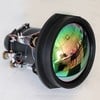Projecting images in radar and medical applications
From DSP-FPGA.com
An FPGA contributes to a reconfigurable system’s performance by allowing a programmer to explicitly and completely dedicate a device to the solution of the regular, uninterrupted streaming aspects of a program.
Examples of computationally intense systems being shrunk by use of FPGAs are of keen interest to us. Filtered backprojection is finding its way into both radar and medical imaging applications, and is well served by FPGAs to handle a portion of the algorithm. The results are outstanding. Searching for an enemy vehicle from a high-flying Unmanned Aerial Vehicle (UAV). Taking a child after a tumble from a bike to the hospital for a CT scan of their broken arm. The imaging techniques in these two seemingly unrelated scenarios rely on the same technology to produce accurate results: the Filtered Backprojection (FBP) algorithm.
Searching for an enemy vehicle from a high-flying Unmanned Aerial Vehicle (UAV). Taking a child after a tumble from a bike to the hospital for a CT scan of their broken arm. The imaging techniques in these two seemingly unrelated scenarios rely on the same technology to produce accurate results: the Filtered Backprojection (FBP) algorithm.
The FBP algorithm reconstructs an image of an object by calculating an exact solution for each pixel from a series of planar image data sets (projections) of the object. Both radar and medical imaging require a high degree of imaging accuracy. The FBP algorithm provides excellent imaging accuracy but at a large computational cost.
Heterogeneous reconfigurable systems provide the required computational power for image reconstruction to both Synthetic Aperture Radar (SAR) Backprojection imaging and Computed Tomography (CT) imaging while delivering such significant benefits as smaller form factors and reduced power consumption.
Products & Services
Product Announcements
|
|
||||||
|
|
||||||
|
Topics of Interest
18.1 INTRODUCTION In the second part of computerized imaging involving Fourier-related transforms, image reconstruction from projections including tomography is discussed. The fundamental...
Background The expectation maximization maximum likelihood method (EMML) discussed in the previous chapter has been the subject of much attention in the medical-imaging literature over the past...
Steven L. Jacques Optoacoustic imaging is an imaging modality based on pressure waves generated in light-absorbing objects by pulsed lasers. An array of acoustic detectors record the time-resolved...
The Pro Observer Unmanned Aerial Vehicle (UAV) sounds like something straight from the pages of a James Bond story: a miniature aircraft, weighing less than a bag of a sugar, that can be stored in a...
Unmanned aerial vehicle, referred to as "unmanned aerial vehicle", or "UAV", is an unmanned aircraft operated by radio remote control equipment and its own program control device, or is operated...
 TABLE OF CONTENTS
TABLE OF CONTENTS 






